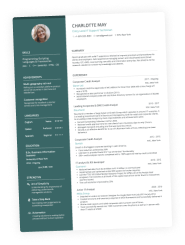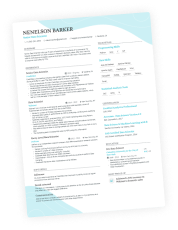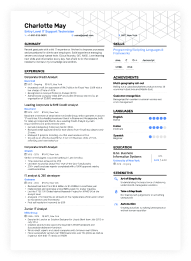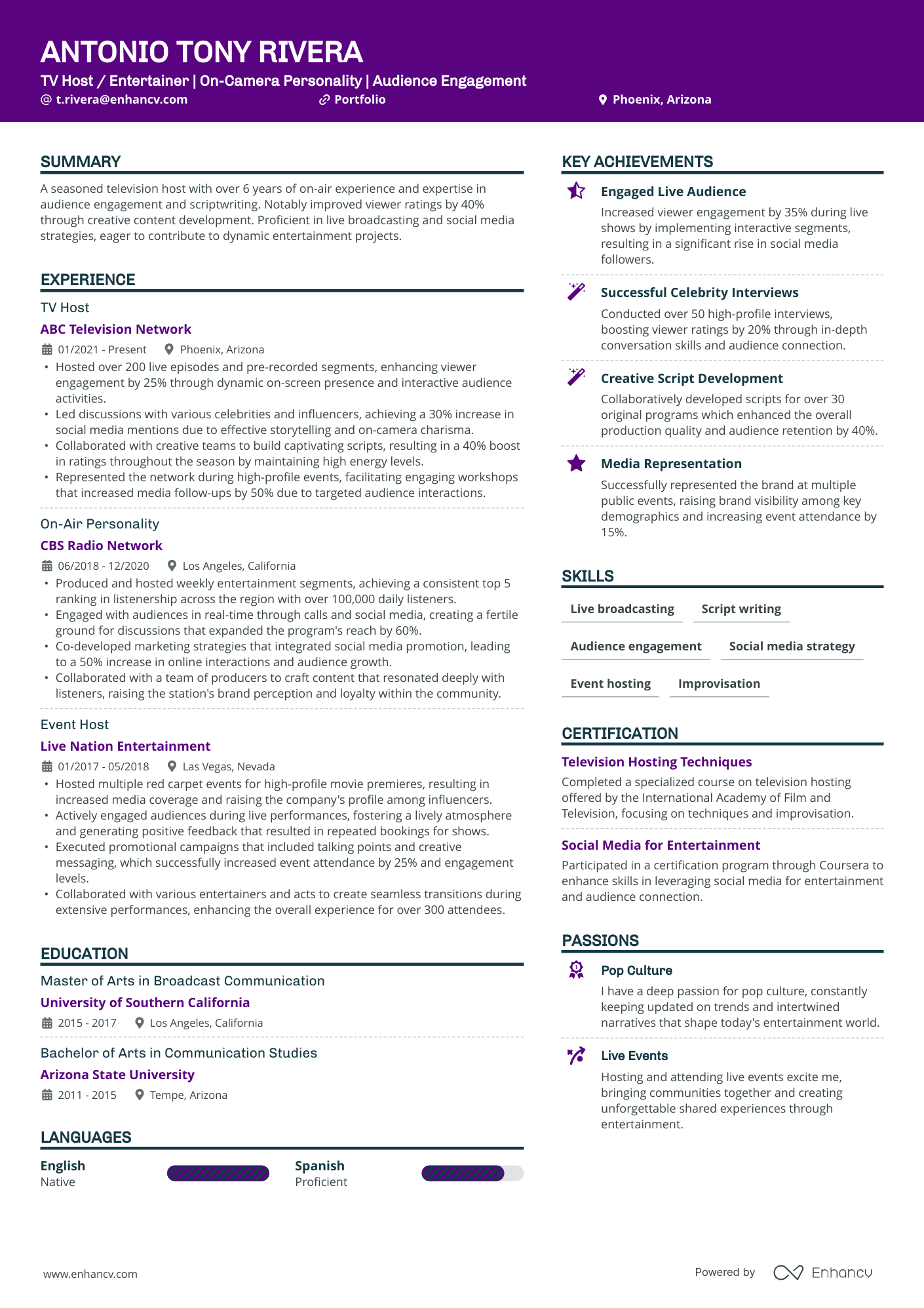In a world where everyone’s trying to stand out, adding a nickname to your resume might feel like the perfect personal touch. After all, creating a resume that rises above the noise is hard enough—why not give it a little flair with the name people actually know you by?
But while an alternative name can make your application feel more approachable—or more “you”—it’s not always the right move. There’s a fine line between memorable and unprofessional, and how you present your name can influence a recruiter’s first impression more than you might think.
So should you put a nickname on a resume? And if you do, what’s the best way to go about it?
Let’s break it down.
Key takeaways
- It’s perfectly acceptable to use a nickname on your resume—as long as it’s professional and recognizable.
- Format your moniker clearly (e.g., Elizabeth “Liz” Johnson) and use it consistently across platforms.
- Some industries or formal roles may still expect a full legal name, so use discretion based on context.
- Using a nickname, westernized name, or pronouns is a personal choice—but clarity matters in hiring systems.
- Always consider including your legal name somewhere on your resume to avoid confusion later in the hiring process
What is a nickname on a resume?
A nickname is a shortened or alternative name you go by—it can be a variation of your real name or something entirely unique. People often use monikers more frequently than their legal names, especially in casual or familiar settings.
Monikers can be personal or professional. While there’s sometimes overlap between the two, chances are if your parents affectionately called you Dumpling, that’s not the name you’re including on your resume.
What jobs use a nickname?
Nicknames are especially common—and often expected—in industries where personal branding, relatability, or performance play a big role. Think sales, media, entertainment, marketing, and tech startups. In these fields, using a familiar or catchy nickname can make you more approachable and memorable from the start.
However, a professional nickname can introduce you before your resume or cover letter ever does. When used consistently, just like a logo, it can become a key element of your personal brand.
So, if you’re asking yourself…
Can I put a nickname on my resume?
The short answer is: yes, you can. In fact, if you’re more commonly known by your nickname—whether professionally or personally—it might make more sense to use it.
In today’s workplace, authenticity and approachability matter more than ever. So if your nickname is how people recognize you, then adding it to your resume isn’t just okay—it can actually be helpful.
Take someone like Lady Gaga (Stefani Germanotta) who built her entire career around a name that felt more aligned with her public persona.
While resumes aren’t stage names, the point stands: names carry identity, recognition, and branding power.
Let’s do a quick quiz to see if you should put your nickname on your resume.
Ask yourself:
- Is this the name I’m known by professionally?
- Is it appropriate for the industry I’m applying to?
- Would I feel confident introducing myself this way in an interview?
- Is it close enough to my legal name to avoid confusion?
- Will it help recruiters recognize me across platforms (LinkedIn, email, etc.)?
If you answered yes to most of these, your alternative name is likely resume-ready.
How to put a nickname on a resume
You go by a nickname in your career, and now you’re wondering how to reflect that on your resume without confusing recruiters—or seeming unprofessional. What’s the best way to include it?
Well, it depends on whether you’ll go by your nickname entirely or you’ll include it in your real name.
Whether your alternative name is a diminutive (shorter) version of your legal name, or something else entirely, let’s review the options.
How to put a nickname on your resume
| Scenario | How to format it | Example |
|---|---|---|
| You want to keep your full name but include your nickname | First name “Nickname” Lastname | Elizabeth “Jazz” Johnson |
| You want to soften your full name with a diminutive name | First name (Nickname) Lastname | Jonathan (Jon)/”Jon” Smith |
| You go exclusively by your nickname or diminutive name and it’s widely recognized | Just use the nickname as your first name | Mike Johnson instead of Michael Johnson |
To include your nickname in your full legal name, use either parentheses or quotation marks. Once you’ve chosen the format that suits you best, make sure the version appears consistently across key elements of your application.
For example:
- Resume header: Use the format you chose in the contact details section at the top of your resume.
- Email signature: If you’re emailing directly, keep your name consistent in your sign-off (e.g., Elizabeth “Liz” Johnson).
- LinkedIn profile: Match your name format on LinkedIn to avoid confusion. Recruiters often cross-reference your name across multiple platforms, so if your nickname and legal name don’t align clearly across these sources, it could raise red flags about your credibility.
PRO TIP
Even if you go by a moniker professionally, make sure your legal name is still clear and accessible—especially for background checks and HR paperwork. Companies might run into legal or payroll issues if your nickname doesn’t match the name on tax forms or IDs. You don’t want a great first impression to get lost in admin confusion.
Nicknames can be a great personal touch—but they’re not always the right choice. Let’s talk about when you might want to leave yours off your resume.
When NOT to use a nickname on a resume
While technically you can have a nickname regardless of your job, some fields, like legal or finance, are more formal than others, and could harm your chances rather than enhance them.
Let’s discuss some of the instances.
When to leave your nickname off your resume
- The industry is highly traditional or conservative. Fields like law, finance, medicine, or government often expect a certain level of formality. Using a nickname here might come across as unprofessional or overly casual.
- Your alternative name is too informal, quirky, or even offensive. If your nickname is playful (e.g., “Bobby Blaze”), it might clash with the tone of your application—or the job you’re applying for.
- It is unrelated to your legal name. Recruiters may get confused or even question your credibility if there’s no clear link between your nickname and your real name, especially if it’s not widely known (e.g., your resume says “Ace Knight” but your LinkedIn and references say “David Clark”).
What about using nicknames with ATS software?
Using a nickname isn’t necessarily an issue, but using only your nickname can be. ATS (applicant tracking systems) scan resumes to match details like your name with other parts of your application—such as LinkedIn, references, or certifications.
If your resume says Maddie Taylor but your background check shows Madeline Taylor, the system might fail to connect them.” To stay on the safe side, include both, like Madeline “Maddie” Taylor, so both the system and recruiters know exactly who you are.
Want a modern, ATS-friendly resume that puts your nickname front and center—without compromising on design?
Check out this standout TV host resume built with Enhancv. It combines modern looks, clean structure, and recruiter-friendly formatting—all while featuring the alternative name exactly where it belongs: at the top. Because personality and professionalism? You can have both.
Now that you know when to use—and when to avoid using—a nickname on your resume, let’s look at two specific situations where name choice can get a bit more nuanced.
Nicknames and international names
If you’re applying for a job in the U.S., but your name originates from a different language or culture, you may find that some people struggle to pronounce it. Don’t think of it as something to fix—your name is part of your identity, and expecting others to respect and learn it is a sign of inclusivity and cultural awareness.
That said, some people choose to use a westernized version of their name—not out of obligation, but for practical or personal reasons. It might make networking easier, reduce mispronunciations, or simply feel more aligned with how they present themselves professionally.
Just like using a nickname, adopting a westernized name is valid if it feels right to you—just make sure it’s consistent across your application documents and channels.
And while cultural considerations are one part of the equation, others may adjust their names for a different reason: to avoid bias.
Nicknames and bias
Some job seekers choose to use alternative names—or even initials—to avoid potential hiring bias. This is especially common if they feel their ethnic or gender-identifying name might lead to unfair treatment during the early stages of the hiring process.
In these cases, adjusting how you present your name can feel like both a protective measure and a strategic choice. It’s one way people shape how they’re perceived before a recruiter even opens their resume.
But names aren’t the only way people choose to express or protect their identity on a resume.
Pronouns on a resume
Aside from a nickname, including your pronouns on your resume is another way to express yourself.
It’s entirely optional but if you decide to include them, here’s how:
- Next to your name in the resume header (e.g., Jordan Lee (they/them))
- In your email signature
- On LinkedIn, next to your name or, if available, in a dedicated pronouns field
Of course, expressing your identity on a resume—whether through a nickname or pronouns—often brings up another question: how do you handle things when your preferred name differs from your legal name?
Legal name vs. preferred name in job applications
When it comes to resumes, it’s important to understand the difference between your legal name and your preferred name—and when to use each.
- Legal name = the name on your government-issued documents
- Preferred name = the name you want people to use when referring to you
Many people use a preferred name on their resume—whether it’s a nickname, a shortened version, a westernized name, or simply the name they feel most comfortable with. This is especially important for transgender and non-binary individuals, or anyone whose legal name doesn’t reflect their identity.
Still, if your preferred name isn’t widely recognizable (think Bill Gates for William Gates), it’s often wise to include your legal name somewhere on your resume. This helps avoid confusion later on.
If you're unsure whether your nickname or preferred name is resume-ready, run it through our resume checker. It’ll flag potential confusion and help polish the details.
Is your resume good enough?
Drop your resume here or choose a file. PDF & DOCX only. Max 2MB file size.
FAQs about nicknames on a resume
If you’ve still got some questions, see if you can find the answer below.
Is it unprofessional to use a nickname?
In today’s dynamic world, using an alternative name on your resume or in professional settings is completely acceptable—as long as it’s appropriate, easy to recognize, and used consistently. Names like Liz for Elizabeth or Alex for Alexander are common and professional. Just avoid overly casual or quirky versions (e.g., Sk8rBoi) that might undermine your credibility.
That said, inconsistency can be a problem—especially if your nickname appears on your resume, but your LinkedIn profile, references, or certifications use your full legal name. Recruiters (and applicant tracking systems) often cross-reference these platforms, and mismatched names can cause confusion or even lead to mistaken identity.
How do I write a nickname in an email?
You can format your name in your email signature the same way you would on your resume—by including both your legal and preferred names if needed.
Here are some examples:
- Elizabeth “Liz” Johnson
- Wei (William) Zhang
This signals to the recipient how you prefer to be addressed while maintaining a connection to your full name for clarity and professionalism.
Should I use my real name on LinkedIn?
You should use the name you go by professionally. It doesn’t have to be your full legal name, but it should match what’s on your resume so recruiters can find and recognize you easily. If there’s a significant difference between your LinkedIn name and your legal name, you can use the “Former Name” field in your profile settings to show both.
Conclusion
Whether you use your full name, a nickname, or something in between, your resume should reflect the version of you that feels most authentic—and that sets you up for clarity, confidence, and connection.
Make one that's truly you.




